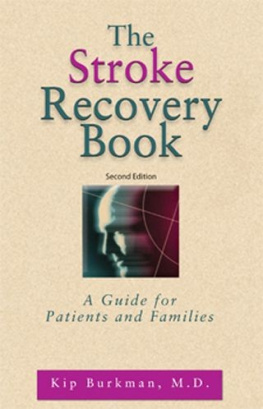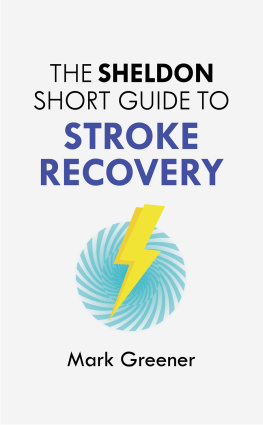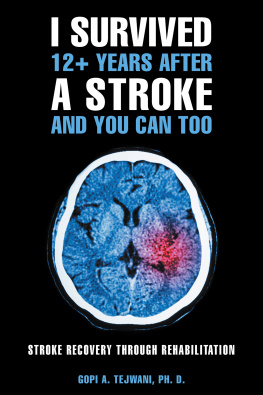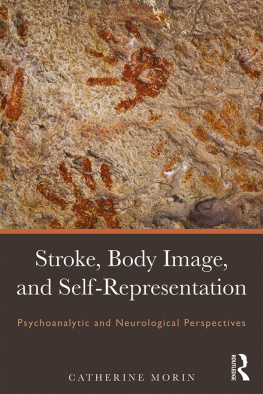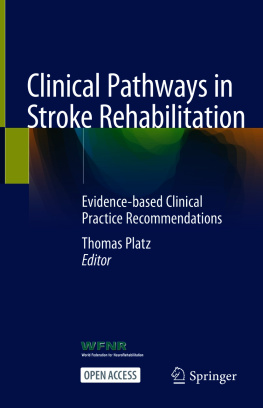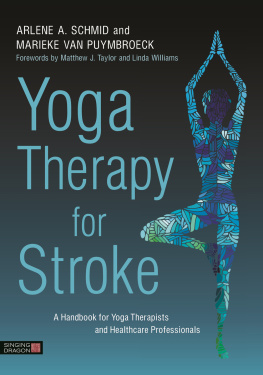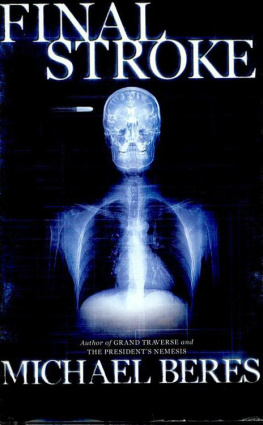
An Addicus Nonfiction Book
Copyright 2010 by Kip Burkman, M.D. All rights reserved. No part of this publication may be reproduced, stored in a retrieval system, or transmitted in any form or by any means, electronic, mechanical, photocopied, recorded, or otherwise, without the prior written permission of the publisher. For information, write to Addicus Books, Inc., P.O. Box 45327, Omaha, Nebraska 68145.
ISBN 978-1-886039-98-8
Second Edition
Cover design by Jeff Reiner and Peri Poloni-Gabriel
Illustrations by Bob Hogenmiller
Model photos by David Jenkins with Shelton Hendricks
Typography by Jack Kusler
This book is not intended to serve as a substitute for a physician. Nor is it the authors intent to give medical advice contrary to that of an attending physician.
Library of Congress Cataloging-in-Publication Data
Burkman, Kip, 1953
The stroke recovery book : a guide for patients and families / Kip Burkman. -- 2nd ed.
p. cm.
Includes index.
ISBN 978-1-886039-98-8 (alk. paper)
1. Cerebrovascular disease--Popular works. I. Title.
RC388.5.B87 2011
616.8106--dc22
2010021383
Addicus Books, Inc.
P.O. Box 45327
Omaha, Nebraska 68145
www.AddicusBooks.com
Printed in the United States of America
10 9 8 7 6 5 4 3 2 1
To my wife, Christine, and my mother, Bettylou. Through their love, I have learned my most
important lessons.
Although the world is full of suffering,
it is full also of overcoming it.
Helen Keller
18801968
Acknowledgments
A number of individuals played a role in the development of this book. I express deep gratitude to them all, especially to the patients and families who, through the years, have helped me learn the art of medicine. Through these people, I have seen the strength of the human spirit in the face of life-changing obstacles.
I wish to thank my colleagues at the Immanuel Rehabilitation Center, who continually help me understand the science of medicine. I also thank the many other healthcare professionals and therapists who shared their perspectives with me for this book. I especially thank Julie Pribyl, Julie Meyer, Sharon Woodard, and Sister Patricia Mokler for their encouragement during the time I was writing the manuscript.
I thank physical therapist Julie Harms for her help in gathering photos for this book. Also, a thank you goes to Laurie Dondelinger, marketing director for Kohlls Pharmacy and Homecare, for funishing photos.
Finally, I thank Rod Colvin of Addicus Books for his support and for encouraging me to write this book.
Introduction
As a rehabilitation physician, I have treated hundreds of stroke patients for almost thirty years. I have seen patients and families being swept into a tailspin of confusion and overpowering emotion as the result of stroke. One of the biggest fears, for both patients and families, is the fear of the unknown. What to expect? What happens next?
My goal in writing this book is to provide answers to some of your questions so that youll be better prepared to navigate your way through this stressful time. Remember, every patient is different, so its not possible to cover individual issues here. Instead, Ive tried to provide a basic knowledge of strokes.
If you are a family member or friend of someone who has had a stroke, I would first advise that you educate yourself about stroke and rehabilitation. Secondly, I suggest that you communicate with your loved ones caregivers. Effective communication can go a long way toward reducing your anxiety. Patients who have supportive families and friends have better recovery outcomes. As much as possible, get involved in the recovery and rehabilitation process.
Remember also, that when someone is suddenly afflicted by a devastating illness, the patient often withdraws mentally and emotionally as a way to cope. Unfortunately, then, the patient doesnt always hear or understand what he or she is being toldall the more reason for families to be informed and participating. My final word of advice is: Be patient and supportive with the stroke patient in your life.
Chapter 1
The Brain and How Strokes Occur
Imagine, for a moment, youre going through your day and suddenly you have a pounding headache and, although youre in familiar surroundings, nothing looks familiar.
Suddenly, youre aware of a spreading warmth between your legs. Youve wet your pants. Youve also fallen to the floor. No matter how hard you struggle to get up, you cant. Neither your arm nor your leg will move. You try calling for help, but the words coming out of your mouth are gibberish. If youre alone, a frightening thought overwhelms you: What if no one finds me?
This scenario describes what it might be like if you suffer a stroke. A frightening proposition, indeed, especially in those first hours and days. You wonder if you will live. Will you be impaired? How long will rehabilitation take? How complete will recovery be? These are just a few of the questions that might race through your mind or the minds of loved ones.
Unfortunately, there are no standard answers to these questions. However, for most individuals, the ability to understand and adapt to this new reality depends largely on their attitudes and efforts as well as on support from family, friends, healthcare professionals, and caregivers.
In this chapter, well discuss the complexities of strokes and how they occur. In order to better understand how strokes affect the brain, lets first review the basics of how the brain works.
Brain Anatomy
The upper brain, or cerebrum , is divided into two hemispheres . The cerebrum contains the cortical area , used for thinking, and the subcortical area , a complex network of nerves that act as relay centers and linking pathways. Each hemisphere has four separate lobes: frontal, parietal, temporal, and occipital . Frontal lobeslocated in the front of the braincontrol thinking, behavioral functions, and body movement. Parietal lobes assist in sensation, concrete thinking (such as math), abstract thinking, vision-space orientation, and language. The temporal lobe is part of the emotional and memory center and also contains language functions. The occipital lobe is the part of the brain that interprets what we see.

The back part of the brain, the cerebellum , controls balance and coordination. Under the cerebrum lies the brain stem . It controls involuntary and automatic survival processes we dont need to think about, such as heart rate, body temperature, breathing, sleeping cycles, and the regulation of some hormones.
How Blood Flows to the Brain
Blood moves from the heart to the brain through the large carotid arteries , which travel up each side of the neck along the windpipe. Once inside the skull, the carotid arteries divide into front and side branches. These blood vessels supply the front two-thirds of the brains outer surface. The vertebrobasilar arteries travel upwards and serve this region as well as the coordination centers and the brain stem.
How the Brain Sends Signals
The wiring of nerves in the brain is complex. Although the two hemispheres of the brain look identical, they handle separate functions. Each hemisphere controls movement and sensation on the opposite side of the body. For example, if you put your left hand under hot running water, the right cerebral cortex interprets the stimulus as pain. To reach for an ice cream cone with your right hand, the left side of the brain generates a signal. The left part of the brain is dominant in right-handed people, while the right portion of the brain is dominant in left-handed individuals.
Next page
